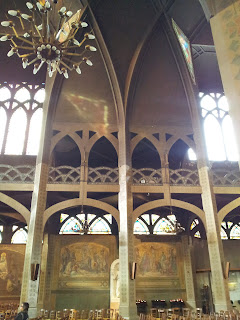Sunday, 20 January 2013
St-Jean-de-Montmartre: a modernist church in Paris
This is somewhat beyond my usual '18e siècle' parameters but it is in Paris, it is about the history of the church, and it is in the '18e arrondissement' so I think we're ok. On a recent trip to Paris I came across this remarkable church from the turn of the century. I know very little about it other than what the guidebooks say, namely that it was built between 1894 and 1904, designed by Anatole de Baudot (student of Viollet-le-Duc and Henri Labrouste), and is most notable for being the first example of reinforced cement in church construction.
Perhaps I've been looking at 17th/18th-century architecture for too long, but I found the use of materials in the interior and exterior wonderfully striking, from the Art Nouveau brick and ceramic tile facade, to the bare cement interior walls beautifully picking up light from the stained glass windows. I'm not sure that my photos do it justice, but it is well worth a detour to explore some of the finer details (like the iron and cement font) and to experience the cavernous space of the nave. If railway stations of the late 19th-century were modelled on medieval cathedrals, then this church brings us full circle, re-appropriating the railway aesthetic to construct a thoroughly modern church that nods politely at Gothic revival. Just look at the clock on the gallery in front of the organ - it makes you feel like you're about to miss a train! The chandeliers are also marvellous and I cannot imagine cement and metal doing a better job at enacting vaulting or arches.
St-Jean-de-Montmartre is on rue des Abbesses in the 18e, just across the road from Metro Abbesses.
Labels:
architecture,
church,
Paris
Subscribe to:
Post Comments (Atom)










No comments:
Post a Comment